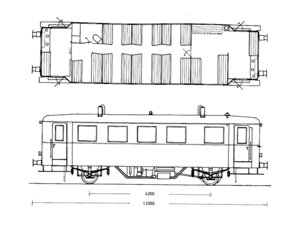DR 135 060
| DR 135 060 | |
|---|---|
|
Dimensional sketch
|
|
| Numbering: | DR: 135 060 GME : T 1 WKB T 3 VLO T3 |
| Number: | 1 |
| Manufacturer: | Waggon- und Maschinenfabrik Aktiengesellschaft vorm. Busch, Bautzen |
| Year of construction (s): | 1935 |
| Type : | A1 dm |
| Genre : | CvT |
| Gauge : | 1435 mm ( standard gauge ) |
| Length over buffers: | 12,200 mm |
| Length: | 11,140 mm |
| Height: | 3,570 mm (without cooler) |
| Width: | 3,060 mm |
| Fixed wheelbase: | 6,200 mm |
| Service mass: | 20,950 kg |
| Top speed: | 75 km / h |
| Installed capacity: | 132 kW (180 PS) |
| Wheel diameter: | 900 mm |
| Motor type: | DWK 2 × 4 V 18 L |
| Motor type: | Eight-cylinder four-stroke diesel engine, horizontal ( boxer engine ) |
| Rated speed: | 1,500 rpm |
| Power transmission: | mechanical according to type TAG after modification hydrodynamic |
| Tank capacity: | 250 l |
| Brake: |
Compressed air brake of the Knorr type from 1937 Hildebrand-Knorr compressed air brake |
| Seats: | 35 + 10 folding seats |
| Standing room: | 25th |
| Floor height: | 1,240 mm |
| Classes : | 3. |
The DR 135 060 railcar is a railcar developed by the Deutsche Reichsbahn in 1935 for passenger traffic on branch lines . In terms of structure, it corresponds to the last row of railcars in the DR 135 002 ... 059 series , it is classified as a VT 135 angular design with mechanical power transmission and also from Waggon- und Maschinenfabrik Aktiengesellschaft vorm. Busch, Bautzen . The distinguishing feature from the series version is the drive system. It has been preserved to this day and is located under the name T3 at the Minden Museum Railway .
history
The railcar was created in an effort to equip the tried and tested DR 135 002… 059 series with a drive system that avoided the disadvantage of the stationary diesel engine of this series. This protruded into the passenger compartment and could only be placed under a bench. Therefore, the drive system in this series was designed as a purely underfloor system . The drive system with the eight-cylinder boxer engine 2 × 4 V 18 L from DWK was chosen . This engine worked according to the Lanova injection process and had a stroke of 180 mm with a piston diameter of 125 mm. The filling control was regulated from the driver's cab using a cable. The idle speed was 550 rpm, the engine mass was 1,360 kg and the dimensions were 1,540 × 1,750 × 850 mm. As with the series vehicles, the power transmission was implemented with the mechanical TAG transmission . Compared to the production vehicles, the railcar lacked the anti-glare screens on the right front window from the start.
Obviously, the drive motor has proven itself, in the literature there is no information about a motor change. Just one year after its commissioning, the mechanical transmission was replaced by a hydrodynamic transmission with the designation 2 W 400/15887 from AEG .
The railcar was intended for use in Regensburg , but was put into operation in Passau . By July 1939 he had covered a total of 225,000 kilometers, which corresponds to 56,000 kilometers a year. When the war broke out, the vehicle, like all diesel vehicles, was shut down. In 1942, after an investigation, it was sold for operation on private railways, after 1945 it came to the Georgsmarienhüttener Eisenbahn and operated there under the name T1 . In 1949, the vehicle was on the Wittlager orbit sold and wrong there as T3 to 1989. Since 1989, is among the vehicle under the name T3 for Verkehrsgesellschaft district of Osnabrück and is supervised by the museum railway Minden.
literature
- Heinz Kurz, The railcars of the Reichsbahn design , EK-Verlag Freiburg, 1988 ISBN 3-88255-803-2 .
Web links
Individual evidence
- ↑ Classification of the railcars on the database of diesel railcars
- ↑ Data sheet about the VT 135.060 at www.roter-brummer.de
- ↑ Heinz Kurz, The railcars of the Reichsbahn design , EK-Verlag Freiburg, 1988, ISBN 3-88255-803-2 , page 138
- ↑ Heinz Kurz, The railcars of the Reichsbahn design , EK-Verlag Freiburg, 1988, ISBN 3-88255-803-2 , page 139
- ^ Photo of the T3 at the WKB
- ^ Photo of the T3 at the Osnabrück district transport company
- ↑ Detailed information on the T3 at www.roter-brummer.de
